Polish Refugees in New Zealand 1944-1951
Introduction
Exhibitions
Who Are We?
The ‘Polish Children’
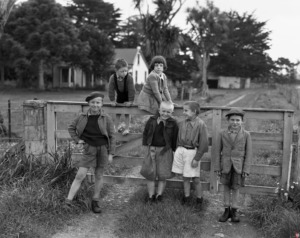 We are a group of children (734) – most of us were orphans or had only one living parent – and adults (105) invited to New Zealand by Prime Minister, Peter Fraser in 1943. We arrived in Wellington on 1 November 1944 on the General Randall an American troopship bringing New Zealand soldiers home on leave. We were taken to a camp at Pahiatua which had been specially set up for us. The Polish Children’s Camp, Pahiatua was our home for the next five years. For many of us those were the happiest years of our lives. At the end of the war we expected to return to Poland. But Poland was now part of a Soviet world; we were given the opportunity to make New Zealand our home. (p12)
We are a group of children (734) – most of us were orphans or had only one living parent – and adults (105) invited to New Zealand by Prime Minister, Peter Fraser in 1943. We arrived in Wellington on 1 November 1944 on the General Randall an American troopship bringing New Zealand soldiers home on leave. We were taken to a camp at Pahiatua which had been specially set up for us. The Polish Children’s Camp, Pahiatua was our home for the next five years. For many of us those were the happiest years of our lives. At the end of the war we expected to return to Poland. But Poland was now part of a Soviet world; we were given the opportunity to make New Zealand our home. (p12)
The Ex-Servicemen
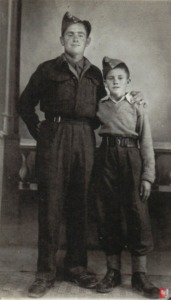 We are a group (200) of mostly fathers and relatives of the children in Pahiatua camp who found ourselves fighting alongside the western Allies during the war. Some of us were part of a Polish army, formed in the Soviet Union after Germany attacked Russia, which was evacuated to the Middle East in 1942. Others of us managed to escape after Poland was invaded by the Wehrmacht and the Red Army, in September 1939. Rather than return to a country dominated by our enemy, we chose to fight for Polish independence in exile. (p13)
We are a group (200) of mostly fathers and relatives of the children in Pahiatua camp who found ourselves fighting alongside the western Allies during the war. Some of us were part of a Polish army, formed in the Soviet Union after Germany attacked Russia, which was evacuated to the Middle East in 1942. Others of us managed to escape after Poland was invaded by the Wehrmacht and the Red Army, in September 1939. Rather than return to a country dominated by our enemy, we chose to fight for Polish independence in exile. (p13)
The Displaced Person
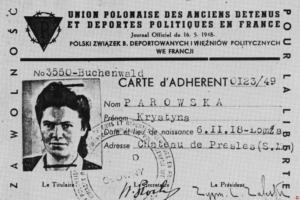 We are a group of Poles (744) who found ourselves in Germany** at the end of the war. We spent the war in concentration camps, prisoner-of-war (POW) camps and forced labour camps. Many of us waited in Germany after the war hoping that we could return to an independent Poland. Finally we too had to accept exile in a foreign country. New Zealand belonged to the International Refugee Organisation which settled Displaced Persons (DPs). Between 1949 and 1951, 4500 DPs of many nationalities came to New Zealand on the Dundalk Bay, Hellenic Prince, and Goya. As New Settlers, we were obliged to work for the government for several years to discharge our debts. (p14)
We are a group of Poles (744) who found ourselves in Germany** at the end of the war. We spent the war in concentration camps, prisoner-of-war (POW) camps and forced labour camps. Many of us waited in Germany after the war hoping that we could return to an independent Poland. Finally we too had to accept exile in a foreign country. New Zealand belonged to the International Refugee Organisation which settled Displaced Persons (DPs). Between 1949 and 1951, 4500 DPs of many nationalities came to New Zealand on the Dundalk Bay, Hellenic Prince, and Goya. As New Settlers, we were obliged to work for the government for several years to discharge our debts. (p14)
Editors notes 1 and 2
1 Displaced Persons found themselves in various European countries including Italy, Austria, Czechoslovakia and France.
2 Minor changes have been made to the text to clarify meanings. All changes have been agreed by Dr. Theresa Sawicka.
Petone Settler’s Museum; Living in Two Worlds, The Polish Community of Wellington; p11, 12, 13, 14
Where did we come from?
World War II
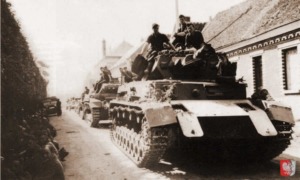 The Tidal wave of war carried the post-war Polish migrants to New Zealand. The German army invaded Poland from the west on September 1939, the Red Army entered Poland’s eastern borderlands on 17 September 1939. The Soviets and Nazis divided Poland almost equally in half according to the Soviet German Pact of Non-Aggression. Life for the Poles in both parts was grim. Between 1939 and 1941, 1.25 million Poles were deported from Soviet-occupied Poland and 2.5 million from German occupied Poland.
The Tidal wave of war carried the post-war Polish migrants to New Zealand. The German army invaded Poland from the west on September 1939, the Red Army entered Poland’s eastern borderlands on 17 September 1939. The Soviets and Nazis divided Poland almost equally in half according to the Soviet German Pact of Non-Aggression. Life for the Poles in both parts was grim. Between 1939 and 1941, 1.25 million Poles were deported from Soviet-occupied Poland and 2.5 million from German occupied Poland.
The journey of the Polish Children and some of the ex-Servicemen begins with deportation from the eastern borderlands. The journey of the DPs and those soldiers made POWs by the German invasion begins in the west.
Eastern Journeys
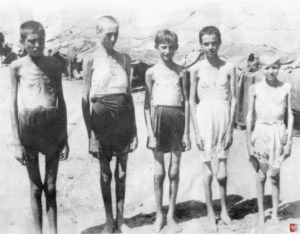 In the period between the Red Army’s invasion of Poland and the German attack on Russia, approximately 1.25 million people were deported from eastern Poland (today western Ukraine and western Byelorussia) to mines, labour camps and prisons deep in the interior of the Soviet Union. They survived horrifying journeys in cattle trains with little sanitation, food or water; months of hard labour on poor rations; and cold arctic winters with inadequate shelter and insufficient clothing.
In the period between the Red Army’s invasion of Poland and the German attack on Russia, approximately 1.25 million people were deported from eastern Poland (today western Ukraine and western Byelorussia) to mines, labour camps and prisons deep in the interior of the Soviet Union. They survived horrifying journeys in cattle trains with little sanitation, food or water; months of hard labour on poor rations; and cold arctic winters with inadequate shelter and insufficient clothing.
After Germany attacked the Soviet Union in 1941, Poles imprisoned in the Soviet Union were granted an ‘amnesty’ and a Polish army was formed. This army gathered in the southern Soviet Republics and was evacuated to the Middle East in 1942. Many civilians were evacuated with it. The Polish Children and their caregivers were a surviving fragment of this mass deportation of Polish citizens.
Western Journeys
 Of the 2.5 million victims of German deportations, 1.5 million were sent from western Poland (soon to become part of the Reich ) to central Poland (which became the General-Gouvernement) and abandoned. Large number of Poles were sent to forced labour camps in the Reich, or forced to work on German farms and in munition factories. Many were sent to concentration camps, the survivors being transferred westwards as the Russians advanced. Polish military POWs were held by the Wehrmacht until the end of the war.
Of the 2.5 million victims of German deportations, 1.5 million were sent from western Poland (soon to become part of the Reich ) to central Poland (which became the General-Gouvernement) and abandoned. Large number of Poles were sent to forced labour camps in the Reich, or forced to work on German farms and in munition factories. Many were sent to concentration camps, the survivors being transferred westwards as the Russians advanced. Polish military POWs were held by the Wehrmacht until the end of the war.
Those Poles who became DPs at the end of the war, had spent the war years in forced labour or POW camps in Germany, or had sought to escape westwards at the end of the war. For some, this meant ten years of life in camps first as prisoners, then as DPs. When the International Refugee Organisation wound up its operations, DPs had to find homes in other countries.
Petone Settlers Museum; Living in Two Worlds, The Polish Community of Wellington; p11-20
Timeline
– On 31 October 1944, 733 children and 105 staff arrive in Wellington on board the USS General Randall.
– The Polish children’s camp is settled on 1 November 1944 and remains in operation until 15 April 1949.
– In response to the installation of a proSoviet communist government in Poland in February 1945, the New Zealand government welcomes the refugees to remain permanently in New Zealand. A small group of adults and children return to Poland.
– From 1945, the children begin leaving the camp for secondary schools or trades.
– Polish High School at Pahiatua closes in August 1946.
– The Polish Boys Hostel in Island Bay, Wellington is established in 6 May 1946.
– The Polish Girls Hostel in Lyall Bay, Wellington is established in 8 December 1947.
– From 1947 to 1949 Polish exservicemen and women related to the children and adults from Pahiatua settle in New Zealand.
– From August 1948, the remaining girls are moved to foster care or to the Polish Girls Hostel in Lyall Bay, Wellington
– The Polish Association in New Zealand based in Wellington is established in 1948 and the first Polish House in Wellington is bought in 1951.
The Pahiatua Polish Children’s Camp closes in February 1949 and is renamed the Pahiatua Reception and Training Centre. It is readied for Displaced Person (DPs) from Europe.
– The remaining youngest boys attend local schools close to Pahiatua for the first term of 1949 and permanently leave Pahiatua Camp in April 1949. After a three month stay at Linton Army Camp in Palmerston North they are transferred to the Hawera Boys Hostel in August 1949
– The Pahiatua Reception and Training Centre accept its first draft of Displaced Persons in June 1949.
– From June 1949 to 1951, New Zealand accepts approximately 4,500 Displaced Persons (DPs) from Europe. There are 744 Poles in this group.
Commentary
Biographies
Click on name to view profile on Wall of Names for immigrants whose profiles have been filled or partially filled. Complete sources of Pahiatua orphanage (children and adults) can be found here. Displaced people who arrived on the ships Dundalk Bay, SS Hellenic Prince, Goya 2 and 3 can be located from Index of Names.
Pahiatua Children
Aitken (Zazulek) Anna
Błażków (Świerczyńska) Stanisława
Bełczącki Czesław
Choros (Gradzik) Dioniza
Czyżowicz (Kupis) Regina
Downey (Kołodyńska) Krystyna
Dudek (Nowakowska) Krystyna
Ellis (Pelc) Helena Wanda
Gawlik Artur
Gazdowicz (Pruszyńska) Eleonora
Henderson (Sondej) Emilia
Jagiełło Józef
Kazimierzak (Kołodzińska) Leokadia
Juchnowicz Jerzy
Kennedy (Błażków) Stanisława
Kołodzińska (Nowatarska) Maria
Kołodziński Jan
Kołodziński Roman
Leparowski Antoni
Lepionka Jan
Lepionka Zdzisław
Lepionka Tadeusz
Łącka (Manterys) Krystyna
Łobaczewska Irena Teresa
Manterys (Sondej) Stefania
Manterys Stanisław
Mazur Piotr
Mazur Tadeusz
Mazur Tadeusz
Michael (Sumicz) Olga
Nowotarski Jan
Norton (Puczko) Zuzanna Krystyna
Pelc Czesław
Robinson (Baziuk) Danuta
Rogers (Matula) Zofia
Roy-Wojciechowski Jan
Rzepka Kazimierz
Rzepka Wanda
Sarniak (Marchewa) Janina
Skwarko Stanisław Krystyn
Smolnicki (Piotuch) Eugenia
Sokalski Józef
Sumicz Wacław
Szymczycha Rudolf
Tomaszyk (Skwarko) Krystyna
Urbonowicz (Manterys) Anna
Waluczewska (Sokalska) Romualda
Wojciechowska-Brooks Krystyna
Zawada Józef
Zawadka (Szymczycha) Salomea
Zazulak (Manterys) Rosalia
Pahiatua Adults
Sr Maria Alexandrowicz
Kołodyńska Stanisława
Skwarko Krystyna
Skwarko Stanisław
Wilniewczyć Ks Michał
Pahiatua Adults
List of Personnel who came with the Polish Children from Iran to New Zealand and looked after the Polish Children until the Polish Children’s Camp in Pahiatua was closed in 1948.
(Note: List is alphabetic by surname)

Ambroziewicz, Maria At the Camp, Maria Ambroziewicz was a teacher at the boys’ primary school. With the closure of the Camp, Maria Ambroziewicz returned to Poland and died in Poland.
Bała,Franciszek Franciszek Bała did not arrive at the Camp with the children but arrived later, from London, being the deputy to the delegate for the Minister of Social Welfare of the Polish-Government-In-Exile in London. With the closure of the Camp, Mr Bała moved to Auckland. Franciszek Bała died in Auckland N.Z.
Benasiewicz, Ewa At the Camp, Mrs Benasiewicz was a member of the domestic staff. She had one daughter – Stefania. With the closure of the Camp, they moved to Hamilton. Ewa Benasiewicz died in Hamilton N.Z.
Bazgier, Ludwika At the Camp, Ludwika Bazgier was a clerk at the Camp office. With the closure of the Camp, she moved to Wellington, where she married Mr Styglan. Ludwika Bazgier-Styglan died in Wellington NZ.
Bednarska, Anna At the Camp, Anna Bednarska was a kindergarten teacher and had 3 daughters– Anna, Elżbieta, Urszula and a son – Aleksander. With the end of WW2, the family moved to Poland. Anna Bednarska died in Ostrołęka, Poland.

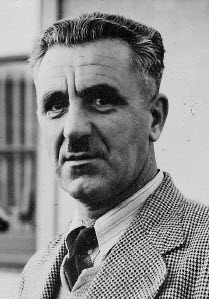 Białostocki, Jerzy Husband of Mrs Białostocki, arrived at the Camp after the demobilisation of the Polish Army and became employed as the boys’ supervisor. With the closure of the Camp, the family moved to Wellington. Jerzy Białostocki died in Wellington N.Z.
Białostocki, Jerzy Husband of Mrs Białostocki, arrived at the Camp after the demobilisation of the Polish Army and became employed as the boys’ supervisor. With the closure of the Camp, the family moved to Wellington. Jerzy Białostocki died in Wellington N.Z.
Blaschke, Zdzisława At the Camp, Zdzisława Blaschke was a teacher at the boys’ primary school. She had a daughter – Lidia. With the closure of the Camp, they both moved to Wellington. Zdzisława Blaschke died in Wellington N.Z.
Bucewicz-Korczak, Maria At the Camp, Maria Bucewicz was a primary as well as a secondary school teacher. She had a mother, Mrs Stanisława Danielewska who was a superannuitant. With the end of WW2, they returned to Poland. Maria Bucewicz died in Poland.
Budzyna-Dawidowska, Dr. Janina At the Camp, Dr.Dawidowska was a dentist. She had a son – Andrzej. With the closure of the Camp, they both moved to Wellington where Dr Dawidowska continued to work as a dentist. Later, her older son Zbigniew and his family, joined Dr .Dawidowska and Andrzej in Wellington. Dr. Janina Budzyna-Dawidowska died in Wellington N.Z.
Bursakowska, Walentyna At the Camp, Walentyna Bursakowska was an occupational therapist. With the end of WW2, she returned to Poland. Walentyna Bursakowska died in Poland.
Chumko, Tekla At the Camp, Tekla Chumko was member of the domestic staff, being the chief cook at kitchen number 1. She had a daughter – Emilia and a son – Witold. Her eldest son Jan, joined the family after the demobilisation of the Polish Army. With the closure of the Camp, Mrs Chumko and her family moved to Lower Hutt. Tekla Chumko died in Lower Hutt N.Z.
Cicha, Paulina At the Camp, Mrs. Cicha was a member of the domestic staff. With the end of WW2, Paulina Cicha returned to Poland where she died.
Czochańska, Dr.Eugenia At the Camp, Dr Czochańska was a medical doctor. She had 2 daughters, Teresa and Zofia. With the closure of the Camp, Dr Czochańska worked in various hospitals in New Zealand in order to have her medical qualifications nostrificated. The family reunited in Wellington where Dr.Czochańska established private medical practice. Dr Eugenia Czochańska died in Wellington N.Z.
Czyżyk, Maria At the Camp, Maria Czyżyk was a teacher. With the end of WW2, she returned to Poland. Maria Czyżyk died in Poland.
Dajnowska, Maria At the Camp, Maria Dajnowska was a member of the domestic staff. She had 4 daughters – Janina, Helena, Wanda and Wiktoria and 2 sons, Andrzej and Stefan. With the closure of the Camp, the family moved to Wellington. Her husband, Mr Dajnowski joined her after the demobilisation of the Polish Army. Mrs Maria Dajnowska died in Lower Hutt N.Z.
Danielewska, Stanisława At the Camp, Stanisława Danielewska was a superannuitant. She came to New Zealand with her daughter, Mrs Bucewicz-Korczak. With the end of WW2, she and her daughter returned to Poland. Stanisława Danielewska died in Poland.
Dąbrowska, Janina At the Camp, Janina Dąbrowska was a carer for the boys and had one of her children, a daughter, Teresa, with her. With the closure of the Camp, Mrs Dąbrowska and Teresa moved to Wellington where they were joined by her other daughter, Maria who came from Poland and her 2 sons – Stanisław and Mieczysław – former members of the Polish Army. Janina Dąbrowska died in Lower Hutt, NZ.
Dmóchowska, Janina At the Camp, Janina Dmóchowska was a carer for the girls. She had a daughter – Teresa. With the closure of the Camp, they both moved to Lower Hutt, Wellington and later after Teresa married Bill Jenner, the family moved to Christchurch. Janina Dmóchowska died in Christchurch.
Glińska, Adela At the Camp, Adela Glińska was a member of the kitchen staff. She had a daughter – Julia and a son – Mikołaj. With the end of WW2, they moved to Auckland. Adela Glińska died in Auckland.
Głowacz,Apolonia At the Camp, Apolonia Głowacz was a member of the domestic staff. She had 3 sons – Antoni, Józef and Marian. With the closure of the Camp, the family moved to Wellington. Apolonia Głowacz died in Wellington N.Z.
Hajduk, Maria At the Camp, Maria Hajduk was a member of the domestic staff. Her daughter, Kazimiera, was born in Iran. With the closure of the Camp, they moved to Hamilton where Mrs Hajduk was joined by her husband, Leon Hajduk, former member of the Polish Army. They had 3 more children born in New Zealand. Maria Hajduk died in Hamilton N.Z.
Herman, Maria At the Camp, Maria Herman was a carer for the boys. She had a daughter Wanda. With the closure of the Camp, they moved to Hamilton. Mrs Herman’s husband, Mr Herman, joined the family while they were still at the Camp. With the closure of the Camp, the family moved to Auckland. Maria Herman died in Auckland.
Holona Józef At the Camp, Józef Holona was inspector of primary schools. Later, he worked as a librarian. With the closure of the Camp, Mr Holona moved to Lower Hutt and later Christchurch. Józef Holona died in Christchurch N.Z.
Hołownia, Emilia At the Camp, Emilia Hołownia was a teacher. She had a daughter – Danuta. With the closure of the Camp, they both returned to Poland. Emilia Hołownia died in Poland.
Jania, Paulina At the Camp, Paulina Jania was a teacher at the girls’ primary school. She had a daughter – Maria. With the closure of the Camp, Mrs Jania and Maria moved to Wellington and later to Canada. Paulina Jania died in Canada.
Jankiewicz, Bolesław At the Camp, Boleslaw Jankiewicz was a gardener. He had 3 daughters – Danuta, Izabela and Teresa and 1 son – Jerzy. With the closure of the Camp, the family moved to Wellington. Bolesław Jankiewicz died in Wellington N.Z.
Jasionowicz, Stefania At the Camp, Stefania Jasionowicz worked at the hospital. She had 3 daughters, Adela, Bernarda and Bronisława. Her two older sons, Adam and Ryszard joined the family with the demobilisation of the Polish Army. Mrs Jasionowicz married Mr Tarasiewicz, also from the Polish Army. With the closure of the Camp, the family moved to Kawhia, New Plymouth. Stanisława Tarasiewicz (Jasionowicz) died in Auckland N.Z.
Kalińska, Wanda At the Camp, Wanda Kalińska was an art teacher. She had a daughter – Danuta and a son -Wiesław. With the end of WW2 the family returned to Poland. Wanda Kalińska died in Poland.
Kasperowicz, Maria At the Camp, Maria Kasperowicz was a hygienist. With the closure of the Camp, she moved to Wellington where Mrs. Kasperowicz was joined by her husband Stanisław Kasperowicz after the demobilisation of the Polish Army. They moved to Wellington where they had a daughter. Maria Kasperowicz died in Wellington.
Kołodyńska, Stanisława At the Camp, Mrs Kołodyńska was a carer for the girls. She had a daughter – Krystyna. With the closure of the Camp, Mrs Kołodyńska moved to Wellington. Stanisława Kołodyńska died in Wellington N.Z.
Kołodzińska, Zofia At the Camp, Zofia Kołodzińska was a member of the domestic staff. She had a daughter – Leokadia and 2 sons – Jan and Roman. Her third son, Stanisław, joined the family after the demobilisation of the Polish Army. With the closure of the Camp, the family moved to Lower Hutt. Zofia Kołodzińska died in Lower Hutt N.Z.
Komodowska, Helena At the Camp, Helena Komodowska was a member of the domestic staff. She had a sister – Maria and a daughter. With the closure of the Camp. Mrs Komodowska married a Polish man who was descendant of the 19th century Polish migrants. They lived in New Plymouth. Helena Komodowska- died in New Plymouth N.Z.
Kornobis, Janina At the Camp, Janina Kornobis was a nurse. She had 4 sisters – Maria, Zofia, Helena and Alfreda. With the closure of the Camp, she moved to Wellington where she married Mr Biesiak and moved to New Plymouth. Later, she married Mr Duyhoven. Janina Kornobis-Biesiak-Duynhoven died in New Plymouth NZ.
Kosińska, Elżbieta At the Camp Elżbieta Kosińska was a hospital nurse. She married Mieczysław Kotlicki and they had a son – Mieczysław. With the closure of the Camp the family moved to Lower Hutt. Elżbieta Kotlicka (Kosińska ) died in Lower Hutt N.Z.
Kotlicki, Mieczysław At the Camp, Mieczysław Kotlicki was a secondary school teacher. With the closure of the Camp, the family moved to Wellington. Mieczysław Kotlicki died in Lower Hutt N.Z.
Kowalczyk, Longina At the Camp, Longina Kowalczyk was a member of the domestic staff. She had 2 sisters, Magdaklenia and Halina. She also had 3 older brothers, Ludwig, Edward and Apolinary who joined her after the demobilisation of the Polish Army. With the closure of the Camp, she moved to Lower Hutt where she married Mr.Kupis, also a former member of the Polish Army. Longina Kupis (Kowalczyk) died in Lower Hutt N.Z.
Kozera, Stefania At the Camp, Stefania Kozera was a scout leader and awarded badges for skills children attained at workshops and camping excursions. She also participated in inviting New Zealand scouts from the neighbouring locality, coordinated festival parades and ceremonial welcomes for visiting dignitaries, including Prime Minister, Rt. Hon. Peter Fraser and Lady Baden-Powel. Mrs Kozera had a daughter Janina, a son Zdzisław and was later joined by her husband, Mr Feliks Kozera, former member of the Polish Army. With the closure of the Camp, the family moved to Wellington. Stefania Kozera died in Wellington N.Z.
Kruk, Elżbieta At the Camp, Elżbieta Kruk was a member of the domestic staff. She had a son, Władysław. With the closure of the Camp, they moved to Wellington. Elżbieta Kruk died in Wellington N.Z.
Krystman, Adam At the Camp, Adam Krystman was a handyman. He had 2 daughters, Janina and Irena. He married Anna Radomska also from the Camp. With the closure of the Camp, the family moved to Hamilton. Adam Krystman died in Hamilton N.Z.
Krzyżanowska, Aleksandra At the Camp, Aleksandra Krzyżanowska was a secondary school teacher. With the end of WW2, she returned to Poland. Aleksandra Krzyżanowska died in Tenczynek Poland.
Kundycka, Elwira At the Camp, Elwira Kundycka was a hospital nurse. She had a son – Stanisław. With the closure of the Camp, they both moved to Wellington and were later joined by Mrs Kundycka’s husband Leopold, and an older son Jacek, both from the Polish Army. Mrs Kundycka died in Wellington N.Z.
Lewandowska, Stanisława At the Camp, Stanisława Lewandowska was a carer for children of kindergarten age. She was fondly called ‘Biała Mama’ – ‘A White Mother’ because she always wore a white overall. With the closure of the Camp, Mrs Lewandowska moved to Wellington and married Michał Mazur. The ‘Rożaniec’ – the ‘Rosary,’ she made out of bread while she was still in Siberia was, after her death, buried with her in Wellington N.Z.
Lipska Maria At the Camp Maria Lipska was a member of the domestic staff as the supervisor of all kitchens. She married Antoni Perkowski. They had a son – Janusz. With the closure of the Camp, they moved to Wellington. Maria Perkowska (Lipska) died in Wellington N.Z.
Łakoma Katarzyna At the Camp, Katarzyna Łakoma was a carer for children of kindergarten age. She had 2 daughters – Danuta and Zenona and 2 sons – Anicet and Józef. With the closure of the Camp, the family moved to Hamilton. Mrs Łakoma died in Hamilton.
Łaszkiewicz-Rosenberg, Olga In the Camp, Olga Łaszkiewicz was a Polish-English Interpreter. Her husband was Mr Rudolf Łaszkiewicz. They had a daughter – Olga. With the closure of the Camp, the family moved to Wellington where Mrs Łaszkiewicz was employed by the Child Welfare Department as a social worker for the Polish Children. Olga Łaszkiewicz- Rosenberg died in Adelaide, Australia.
Łaszkiewicz-Rosenberg, Rudolf Husband of Olga Łaszkiewicz-Rosenberg. At the Camp, Rudolf Łaszkiewicz-Rosenberg was in charge of the Camp stores. With the closure of the Camp, the family moved to Wellington. Rudolf Łaszkiewicz-Rosenberg died in Wellington NZ.
Maciejowska, Weronika At the Camp, Weronika Maciejowska worked as a member of the domestic staff. With the closure of the Camp, she moved to Wairarapa, North of Wellington. Weronika Maciejowska died in Nelson N.Z.
Mełgieś, Janina Janina Mełgieś gave birth to a daughter Halina when still in Isfahan, Iran. At the Camp, she spent time looking after the baby and was later joined by her husband, Stanisław Mełgieś who served in the Polish Army. With the closure of the Camp, the family moved to Hawkes Bay. Janina Mełgieś died in Lower Hutt N.Z.
Merwid, Waleria At the Camp, Waleria Merwid was supervisor of the Polish girls’ sewing room. She also taught a group of girls national dances from various countries for concert performances, as well as social dancing for teenage recreation. With the closure of the Camp, Waleria Merwid moved to the USA and later died in America.
Michalik, Jadwiga At the Camp, Jadwiga Michalik was teacher at the boys’ school. She had a son – Wojciech and a nephew – Zbigniew. With the closure of the Camp, Mrs Michalik and the boys moved to Wellington. Mrs Michalik died in Dunedin N.Z.
Nawalaniec, Helen At the Camp, Helena Nawalaniec was a member of domestic staff. She had a son – Jan and 3 daughters Stefania, Władysława and Helena. With the closure of the Camp, they moved to Hamilton. Helena Nawalaniec married Mr Woś, who arrived after the demobilisation of the Polish Army. Helena Woś (Nawalaniec) died in Hamilton N.Z.
Nawalaniec Stefania At the Camp, Stefania Nawalaniec was working in the sewing room. With the closure of the Camp, she moved to Hobart, Australia. Stefania Nawalaniec died in Hobart, Australia.
Nowakowska, Maria At the Camp Maria Nowakowska was a member of the domestic staff. She had 2 daughters – Krystyna and Irena. With the closure of the Camp, the family moved to Hamilton. Mrs Nowakowska died in Hamilton N.Z.
Okołów, Maria At the Camp, Maria Okołów was a teacher at the boys’ primary school. She had 1 daughter – Irena. With the closure of the Camp they moved to Wellington. Mrs Okołów’s husband, Kazimierz Okołów, joined the family after the demobilisation of the Polish Army. Mrs Okołów died in Wellington N.Z.
Olechnowicz, Tatjana At the Camp, Tatjana Olechnowicz was a teacher at the boys’ primary school. Her husband was Marian Olechnowicz who was also at the Camp. With the closure of the Camp, the family moved to Wellington. Tatjana Olechnowicz died in Wellington N.Z.
Olechnowicz, Marian At the Camp, Marian Olechnowicz was a secondary school teacher. With the closure of the Camp, both moved to Wellington. Mr and Mrs Olechnowicz set up a University Scholarship Trust for university students of Polish origin. Marian Olechnowicz died in Wellington.
Ostrowska, Petronela At the Camp, Petronela Ostrowska was a member of the domestic staff. She had a son, Tadeusz who died at the Camp. With the closure of the Camp, Mrs Ostrowska moved to Wellington. Her elder son, Władysław, joined her after the demobilisation of the Polish Army. Petronela Ostrowska died in Wellington N.Z.
Pantalejew, Zofia At the Camp, Zofia Pantalejew was a hospital nurse. With the closure of the Camp she moved to Australia. Zofia Pantalejew died in Brisbane Australia.
Perkowski, Antoni At the Camp, Antoni Perkowski was an accountant and an art teacher. He married Maria Lipska who had a daughter – Jadwiga. Mr and Mrs Perkowski had a son – Janusz. Mr Perkowski painted the well-known and, for the Polish community, a very memorable painting, “Jesus in the Tomb” which was displayed at the Camp chapel during Easter. With the closure of the Camp, they moved to Wellington. Antoni Perkowski died in Wellington N.Z.
Petrus, Maria At the Camp, Maria Petrus was a carer for the boys. She had a son, Michał. With the closure of the Camp, they moved to Napier. Maria Petrus died in Napier N.Z.
Piatkowska, Maria At the Camp, Maria Piatkowska was a teacher at the boys’ primary school. With the end of WW2, she returned to Poland. Maria Piatkowska died in Poland.
Pietrasińska, Wanda At the Camp, Wanda Pietrasińska was a teacher of religion. She had a mother who was a superannuitant. With the closure of the Camp, they moved to Wellington. Wanda Pietrasińska died in Sydney Australia.
Piotrkowska, Zofia At the Camp, Zofia Piotrkowska was a carer for the boys. She had a daughter Maria. With the closure of the Camp, they moved to Lower Hutt. Mrs Piotrkowska married Bronisław Nawrocki who came to New Zealand after the demobilisation of the Polish Army and who already had 4 daughters, Jadwiga, Maria, Janina and Helena and a son, Czesław at the Camp. Zofia Nawrocka (Piotrkowska) died in Wellington N.Z.
Powierza, Józefa At the Camp, Józefa Powierza was a carer for the boys. She had 3 sons – Lech, Marek and Witek and a mother – Mrs Wojdyga who was a superannuitant. With the closure of the Camp, the family moved to Hamilton where Mrs Powierza married Mr.King. Józefa King (Powierza) died in Hamilton N.Z.
Pytlos, Karolina At the Camp, Karolina Pytlos was a carer for the boys and was known for her skills in teaching the Polish regional dance – Góralski. She had a daughter, Maria who was born in a Russian Gulag in Siberia, the Soviet Union. Mrs Pytlos was the holder of the highest Polish Military Order – the Virtuti Military Cross – which she received for her participation in WW1. With the closure of the Camp, they moved to Wellington. Karolina Pytlos died in Wellington N.Z.
Radomska, Anna At the Camp, Anna Radomska was a member of the domestic staff and married Adam Krystman from the Camp. With the closure of the Camp, Anna and Adam moved to Hamilton. Anna Krystman (Radomska) died in Hamilton N.Z.
Rolińska, Julia At the Camp, Julia Rolińska was a teacher at the girls’ primary school and later, a carer. With the closure of the Camp, she moved to Wellington. Julia Rolińska died in Wellington N.Z.
Rombel, Stefania At the Camp, Stefania Rombel was member of the domestic staff. She had 3 sisters, Helena, Maria and Zofia and 1 brother, Piotr. With the closure of the Camp, Stefania Rombel moved to Lower Hutt and married Czesław Bireta who came to N.Z with the transport of the ‘Displaced People’ from Germany. They had a daughter, Barbara. Stefania Bireta (Rombel) died in Lower Hutt. N.Z.
Rubisz, Malwina At the Camp, Malwina Rubisz was a librarian. She had a daughter – Malwina (Wisia). With the closure of the Camp, they both moved to Auckland where Mrs.Rubisz was joined by her husband Zygmunt Rubisz. Malwina Rubisz died in Auckland N.Z.
Rudnicka, Wilhelmina At the Camp, Wilhelmina Rudnicka was a teacher at the boys’ primary school. She had 2 sons, Witold and Henryk. With the closure of the Camp, the family moved to Wellington. Wilhelmina Rudnicka died in Taupo N.Z.
Sawicka, Maria At the Camp, Maria Sawicka was a nurse. With the closure of the Camp, she moved to Wellington. Maria Sawicka died in Wellington N.Z.
Sawlewicz, Gizella At the Camp, Gizella Sawlewicz was a teacher at the girls’ primary school, as well as a teacher in physical education. She had 2 daughters, Danuta and Halina. With the closure of the Camp, the family moved to Wellington where Mrs Sawlewicz was joined by her husband, Romuald Sawlewicz, former member of the Polish Army. Gizella Sawlewicz died in Masterton N.Z.
Skwarko Krystyna At the Camp, Krystyna Skwarko was the principal of the boys’ primary school. Stanisław Skwarko was her husband. They had 2 children- Krystyna and Stanisław. With the closure of the Camp, the family moved to Wellington. Krystyna Skwarko died in Bandung, Indonesia but her ashes are buried in Canberra, Australia.
Skwarko Stanisław The husband of Krystyna Skwarko. Stanisław Skwarko was a treasurer at the Camp. With the closure of the Camp, the family moved to Wellington. Stanisław Skwarko died in Canberra, Australia.
Snarska, Weronika At the Camp, Weronika Snarska was a teacher at the boys’ primary school, as well as a carer. With the closure of the Camp, Mrs Snarska moved to Wellington. She was joined by her son Adam and her daughter, Maria, after the demobilisation of the Polish Army. Weronika Snarska died in Wellington N.Z.
Sójka, Maria At the Camp, Ludwika Sójka was a teacher at the girls’ primary school, as well as a carer. With the closure of the Camp, she moved to the United Kingdom. Maria Sójka died in the U.K.
Sprusińska, Zofia At the Camp, Zofia Sprusińska was a carer for the girls. She had a daughter – Barbara. With the closure of the Camp, Mrs Sprusińska moved to Wellington where she married Captain Tadeusz Niefiedowicz – captain of the Polish ship, Narwik of the Polish Ocean Line, Gdynia-Ameryka. Zofia Niefiedowicz (Sprusińska) died in Sydney but her ashes were brought back to Wellington and buried in Wellington N.Z.
Surynt, Salomea At the Camp, Salomea Surynt was a teacher at the girls’ primary school. She had a son, Jerzy and a daughter, Zofia. With the closure of the Camp, the family moved to Auckland where Mrs Surynt was joined by her husband, Mr Surynt after the demobilisation of the Polish Army. Salomea Surynt died in Auckland N.Z.
Sygierycz, Olga At the Camp, Olga Sygierycz was both, a primary and a secondary school teacher. With the end of WW2, she returned to Poland. Olga Sygierycz died in Poland.
Szłapak, Maria At the Camp, Maria Szłapak worked as a member of the domestic staff. She had a daughter, Adela. Mrs Szłapak was joined by her husband Mr Szłapak after the demobilisation of the Polish Army. With the closure of the Camp, they moved to Wellington. Maria Szłapak died in Wellington N.Z.
Szymańska, Jadwiga At the Camp, Jadwiga Szymańska worked as an office typist. With the closure of the Camp, she moved to Auckland. Mrs Szymańska’s husband, Mr Szymański arrived in N.Z. after the demobilisation of the Polish Army. They had a son, Zbigniew. Mrs Szymańska died in Auckland N.Z.
Szymulska, Helena At the Camp, Helena Szymulska was a hospital nurse. She was the sister of Stanisław Skwarko. With the end of WW2, she returned to Poland to reunite with her 2 sons – Aleksander and Zdzisław. Helena Szymulska died in Białystok, Poland.
Szysz, Zofia At the Camp, Zofia Szysz was a nurse at the hospital. She had a daughter, Danuta. At the end of WW2, she was joined by her husband who arrived after the demobilisation of the Polish Army. With the closure of the Camp, the family moved to Wellington. Mrs Szysz died in Wellington N.Z.
Świerczyńska, Jadwiga At the Camp, Jadwiga Świerczyńska worked at the sewing workshop. With the closure of the Camp, she moved to Wellington and married Mr Trybuła who came to New Zealand after the demobilisation of the Polish Army.
Świerczyńska, Janina At the Camp, Janina Świerczyńska was a member of the domestic staff. With the closure of the Camp, she moved to Wellington where she married Mikołaj Nowotarski who served in the Polish Army and had a daughter, Maria and a son Jan who were already at the Camp, having arrived in New Zealand with the Polish children. Janina Nowotarska (Świerczynska) died in Wellington.
Świerzyńska-Frysz, Bronisława At the Camp, Bronisława Świerzyńska was a primary school teacher. With the closure of the Camp, she returned to Poland. Bronisława Frysz-Świerzyńska died in Kraków Poland.
Tietze, Jadwiga At the Camp, Jadwiga Tietze was a teacher. She had a son, Tadeusz. With the closure of the Camp, She and her husband moved to Hawera where her husband became director of the Polish Boys’ hostel. Jadwiga Tietze died in Brisbane, Australia.
Tobolska, Sr. Anna – Sister Imelda Was member of the Ursuline Order. At the Camp, she was a carer for the boys’ group. With the closure of the Camp she worked at the Polish Girls’ Hostel in Lyall Bay Wellington and was later recalled to Poland. Sr. Imelda died in Łódź, Poland.
Wenckiewicz, Helena At the Camp, Helena Wenckiewicz was a teacher in physical education. She had 2 daughters, Krystyna and Jolanta. With the end of WW2, they returned to Poland. Helena Wenckiewicz died in Poland.
Węgrzyn, Maria At the Camp, Maria Węgrzyn was a carer for pre-school children. She had 3 sisters –Józefa, Władysława, and Franciszka and a brother Bronisław. With the closure of the Camp, the family moved to Wellington. Her brother Jan was reunited with the family after the demobilisation of the Polish Army. Maria Węgrzyn married Jan Wypych who also came from the Polish Army.
Wilniewczyc, Fr. Michał Fr Michał Wilniewczyc was a Catholic Priest who, apart from his priestly duties, conducted religious studies. Later, he was moved to Beirut, Rome and then to Drohiczyn, Poland. Fr Wilniewczyc died in Drohiczyn, Poland.
Wojdyga, Antonina Antonina Wojdyga was the mother of Józefa Powierza – fondly called ‘Babcia’ – a grandmother. Mrs. Wojdyga was a superannuitant. With the closing of the Camp, the family moved to Hamilton. Antonina Wojdyga died in Hamilton.
Wojtowicz, Balbina At the Camp Balbina Wojtowicz was a teacher at the boys’ primary school. She was the sister of Jadwiga Wojtowicz. With the end of WW2, she returned to Poland. Balbina Wojtowicz died in Poland.
Wojtowicz, Jadwiga At the Camp, Jadwiga Wojtowicz was a teacher. With the end of WW2, she and her sister returned to Poland. Jadwiga Wojtowicz died in Poland.
Woźniak, Teodozja At the Camp, Teodozja Woźniak was a member of the domestic staff. She had 3 daughters, Weronika, Maria and Halina and a son – Mikołaj. With the closure of the Camp, they moved to Wellington. Teodozja Woźniak died in Wellington N.Z.
Wypych, Maria While at the Camp, Maria Wypych was a member of domestic staff. She had 4 sisters – Wiktoria, Józefa, Genowefa and Teresa and one brother Franciszek. Her elder brothers – Jan, Konstanty, Władyslaw and Julian joined the family after the demobilisation of the Polish Army. While still at the Camp, Maria Wypych married Mr Jane, a New Zealander, who worked as a cook at the Pahiatua Camp. They had a son, Aleksander and a daughter Irena. The family moved to Wairoa. Maria Jane (Wypych) died in Wellington and her ashes were taken to Wairoa N.Z.
Zatorska, Waleria At the Camp, Waleria Zatorska was a member of the domestic staff. She had a daughter, Anna. With the closure of the Camp, they moved to Palmerston North. Waleria Zatorska died in Palmerston North N.Z.
Zięciak, Halina At the Camp, Halina Zięciak was the Principal of the secondary school. She was also an artist – wrote poetry, was the author of a Christmas play and constructed background scenery as well as designed costumes for theatrical plays. With the closure of the Camp, she and her son – Marek, moved to the United Kingdom. Halina Zięciak died in Manchester, U K.
Zysk, Stefania In the Camp, Stefania Zysk was a member of the domestic staff. With the closure of the Camp, she moved to Wellington where she married Władysław Łabędź who, prior to coming to N.Z. served in the Polish Army. He had 3 daughters, Helena, Regina and Janina who came to New Zealand with the Polish children. Stefania Łabędź (Zysk) died in Wellington N.Z.
Żerebecka, Jadwiga At the Camp, Jadwiga Żerebecka was the principal of the girls’ primary school. She also taught and conducted the Polish children’s choir. On the first Polish National Day – the Constitution Day – to be celebrated in New Zealand, the choir travelled to Wellington and performed songs in Polish, English and Maori to the accompaniment of the New Zealand Symphony Orchestra. Mrs Żerebecka had a daughter – Zofia. With the end of WW2, they returned to Poland. Zofia Łuszczewska, Zofia Żerebecka’s friend, went with them. Jadwiga Żerebecka died in Poznań Poland.
Ex-Servicemen
Adamiak (Gradzik) Halina Małgorzata
Banas Władysław
Baziuk Jan
Baziuk Zenon
Błażków Władysław
Butler (Baziuk) Anna
Dąbrowski Stanisław
Gazdowicz Józef
Smolnicki Grzegorz Adolf
Piotuch Michał
Tomaszyk Czesław
Rosner (Gradzik) Bronisława
Waluczewski Stanisław
Wypych Julian
Displaced Persons
Bagińska (Czerwinska) Zofia
Kołodyński Henryk
Iwanica Kazimerz
Sarniak Antoni
Tarasiewicz (Kunachowicz) Aleksandra
Tarasiewicz Aleksander
van Linden (Tarasiewicz) Maria
Acknowledgements
The New Zealand Museum Gallery Room “Polish Refugees in New Zealand – Deportees Forcibly Taken to Siberia, Ex-Servicemen and Displaced Persons” was created by a workgroup from Wellington, New Zealand under the umbrella of the Kresy-Siberia Foundation. The group was led by Irena Lowe (Smolnicki), and assisted by Dr.Theresa Sawicka, Wesław Wernicki, Jackie Rzepka, Adam Manterys and Mary-Anne Morgan (Baziuk).
Theresa and Wesław have provided the team with professional assistance in the field of history. Irena, Jackie, Adam and Mary-Anne are all first generation New Zealanders and descendants of family members forcibly deported from Kresy during World War II, who subsequently came to New Zealand either as children bound for Pahiatua Children’s Camp, or as ex-servicemen and women or displaced persons.
We also acknowledge all those Pahiatua children and adults, ex-servicemen and women, displaced persons and New Zealanders who have written about their own or their family’s experiences in books and journals and provided a wonderful history in text, photos and documents over many decades. The team has not set out to rewrite the history but rather to collate the existing stories in a structure so that the interested readers and the following generations can access the stories on-line and view the history as a mosaic. We are humbled by their experiences.
We are grateful to our sponsors who have enabled the publication of this gallery.

Stowarzyszenie Polskich Kombatantów SPK (Polish Ex-Servicemen’s Association)
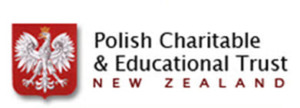
Polish Charitable and Educational Trust New Zealand

The Morgan Foundation

Dr Zbigniew Popławski – in memory of the Popławski family
Andy and Anthony Bogacki – in memory of the Bogacki and Zielinski family
Eugenia Smolnicka – in memory of Michał and Antonina Piotuch
Jackie Rzepka – in memory of the Rzepka family
Steve Witkowski – in memory of the Witkowski family
Bibliography
Sources
Alexandrowicz, S.Monica 1998. “Z Lubcza na Antypody“. Seria: Ocalić od zapomnienia -1. Zgromadzenie Siótr Urszulanek SJK.
Beaupré-Stankiewicz, Irena, Danuta Waszczuk-Kamieniecka, and Jadwiga Lewicka-Howells. 1989. Isfahan – City of Polish Children. 3rd ed. London: Association of Former Pupils of Polish Schools, Isfahan and Lebanon.
Beaupré-Stankiewicz, Irena, Danuta Waszczuk-Kamieniecka, and Jadwiga Lewicka-Howells. 1987. Isfahan – Miasto Polskich Dzieci. 1st ed. London: Kolo Wychowanków Szkól Polskich, Isfahan i Liban.
Chibowski, Ks. Andrzej. 2012. Kapłańska Odyseja Ząbki. Original language edition. Polska: Apostolicum.
Chibowski, Dr. Andrzej. 2013. A Priest’s Odyssey. 1st English- language edition. Wellington, New Zealand: Future Publishing.
Dabrowski, Stanislaw. 2011. Seeds in the Storm. Waikanae, NZ: Maurienne House.
Ducat, Michelle, Mealing, David, Sawicka Theresa, and Petone Settlers Museum. 1992. Living in Two Worlds: The Polish Community of Wellington Wellington: Petone Settlers Museum/Te Whare Whakaaro o Pito-one
Jagiello, Józef. 2005. One Man’s Odyssey. Edition 2005. Józef Jagiello.
Department of Labour, New Zealand Immigration Service. 1994. Refugee Women: The New Zealand Refugee Quota Programme. Wellington: Department of Labour, New Zealand Immigration Service.
Lowrie Meryl. 1981 The Geneva Connection, Red Cross in New Zealand. Wellington: New Zealand Red Cross Society.
Manterys, Adam, Stefania Zawada, Stanislaw Manterys, and Józef Zawada. 2008. New Zealand’s First Refugees: Pahiatua’s Polish Children (2nd ed.). Wellington: Polish Children’s Reunion Committee.
Manterys, Adam, Stefania Zawada, Stanislaw Manterys, and Józef Zawada. 2012. New Zealand’s First Refugees: Pahiatua’s Polish Children (3rd ed.). Wellington: Polish Children’s Reunion Committee.
Manterys, Adam, Stefania Zawada, Stanislaw Manterys, and Józef Zawada. 2006. Dwie Ojczyzny: Polskie dzieci w Nowaj Zelandii Tułacze wspomnienia. Warszawa: Społeczny Zespól Wydania Książki o Polskich Dzieciach w Nowej Zelandii.
New Zealand Education Deptment. 1945. “Polish Children in New Zealand.” New Zealand School Journal, 1937-vol. 39 No 5, Part III:147-152.
Polish Women’s League. 1991. Wiązanka myśli i wspomnie / Koło Polek = A Bouquet of thoughts and reminiscences. Wellington, N.Z.: The League.
Rodgers, Owen. 2011. Adventure Unlimited – 100 years of Scouting in New Zealand 1908-2005. Wellington: Scout Association of New Zealand.
Ronayne Chris. 2002. Rudi Gopas – a biography. David Ling Publishing Limited.
Skwarko, Krystyna. 1972. Osiedlenie Młodzieży Polskiej w Nowej Zelandii w r. 1944. Londyn, Poets’ and Painters’ Press.
Skwarko, Krystyna. 1974. The Invited. Wellington: Millwood Press.
Spławska, Władysława Seweryn. 1993. Harcerki w Zwiądzku Harcerstwa Polskiego: Poczatki i Osiągnięcia w Kraju oraz 1939-1949 poza Krajem. Głowna Kwatera Harcerek ZHP poza Krajem.
Suchanski, Alina. 2006. Polish Kiwis: Pictures from an Exhibition. Christchurch: Alina Suchanski.
Suchanski, Alina. 2012. Alone : an inspiring story of survival and determination. Te Anau, N.Z.: A. Suchanski.
van der Linden, Maria. 1994. An Unforgettable Journey. Second Revised ed. Palmerston North: Dunmore Press.
Tomaszyk, Krystine. 2004. Essence. Palmerston North: Dunmore Press.
Tomaszyk, Krystyna. 2009a. Droga i Pamięć: Przez Syberie na Antypody. Warszawa: Wydawnictwo Trio.
Zdziech, Dariusz. 2007. Pahiatua – “Mała Polska” małych Polaków. “Societas Vistulana” .
Other Books
Beck, Jennifer, and Lindy Fisher. 2007. Stefania’s Dancing Slippers. Auckland: Scholastic New Zealand. [Children’s Book]
Domanski, Witold (Vic). 2011. A New Tomorrow: A story of a Polish-Kiwi family. Masterton, NZ: Tararua Publishing.
Jaworowska, Mirosława. 2011. Golgota i Wybawienie: Dzieci Pahiatua od Syberii do Nowej Zelandii – Cztery Pory Roku jak Cztery Pory Życia Warszawa: Studio Jeden.
Kałuski, Marian. 2006. Polacy w Nowej Zelandii. Toruń, Poland: Oficyna Wydawnicza Kucharski.
Lochore, R. A. 1951. From Europe to New Zealand: An Account of our Continental European Settlers. Wellington: A. H. & A. W. Reed in conjunction with the New Zealand Institute of International Affairs.
Lubelski, Katolicki Uniwersytet. 2007. Z Sybiru na drugą półkulę : wojenne losy Polskich dzieci z Pahiatua. Lublin: Wydawn. KUL.
Pobóg-Jaworowski, J. W. 1990. History of the Polish settlers in New Zealand, 1776-1987. Warsaw: CHZ Ars Polona.
Ogonowska-Coates, Halina. 2008. Krystyna’s Story: A Polish refugees journey. Dunedin: Longacre Press.
Roy-Wojciechowski, John, and Allan Parker. 2004. A Strange Outcome: The Remarkable Survival Story of a Polish Child. Auckland: Penguin Books.
Szymanik, Melinda. 2013. One Winter’s Day in 1939. Auckland: Scholastic. [Children’s Book]
Turol, Sophia. 2010. Sophia’s Challenging Journey: Self-published.
Wiśniewska-Brow, Helena. Give Us This Day. Victoria University Press.
Other Materials
CraftInc. Films. 2015. Polish Children of Pahiatua. 70th Reunion – HD. Wellington: CraftInc Films. Produced by Wanda Lepionka and David Strong. [Film].
Gillis, Willie Mae. 1954. The Poles in Wellington, New Zealand. Edited by Department of Psychology. Vol. No. 5 Publications in Psychology. Wellington: Victoria University College. [Research]
Krystman-Ostrowski, Teresa Marja. 1975. The Socio-Political Characteristics of Polish Immigrants in Two New Zealand Communities, Department of Politics, University of Waikato, Hamilton. [Thesis]
National Film Unit. 1944. Weekly Review 169. Wellington: National Film Unit.
O’Brien, Kathleen. 1966. The Story of Seven-Hundred Polish Children. Wellington: New Zealand National Film Unit. [Film]
Ogonowska-Coates, John Anderson in collaboration with Halina. 1996. Exiles: The Story of a Polish Journey. Wellington: Ace of Hearts Production in Association with Polish Television. [Film]
Sawicka-Brockie, Theresa. 1987. Forsaken Journeys, Department of Anthropology, Auckland University, Auckland. [PhD Thesis]
Stowarzyszenie Polaków w Christchurch. 2004. Poles Apart: Historia 733 Polskich Sierot. Christchurch: Canterbury Telivision (CTV). [Film]
Tomaszyk, Krystyna. 2009b. The Story of the Polish Children in Isfahan – Iran 1942-1944. [DVD]
Indexes Of Names
Dundalk Bay – Ship carrying Displaced Persons to New Zealand
Goya Voyage 2 – Ship carrying Displaced Persons to New Zealand
Goya Voyage 3 – Ship carrying Displaced Persons to New Zealand
Orphanage – Pahiatua – New Zealand
S.S. “RANGITIKI” – Ship carrying ex-servicemen related to Pahiatua orphans to New Zealand
SS Hellenic Prince – Ship carrying Displaced Persons to New Zealand
Contact
Kresy-Siberia (New Zealand)
PO Box 853 Wellington 6140 New Zealand
e-mail: NZ@Kresy-Siberia.org